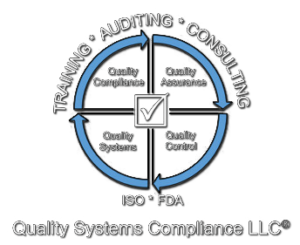Quality Systems Compliance L.L.C.
Your compliance partner…
ALCOA Principles: Data Integrity for the FDA Regulated Industry
FDA Warning Letters issued for data integrity issues are on the rise. ALCOA stands for; Attributable, Legible, Contemporaneous, Original, and Accurate is a technique that can help ensure paper and electronic data are compliant with FDA Regulations and Guidances. The ALCOA technique can help provide an audit trail that captures details such as additions, deletions, or alterations of information in an electronic record without obscuring the original record. Audit trails facilitate the reconstruction of the details relating to the electronic record.
ALCOA Principles
The ALCOA acronym was first coined by Stan W. Woollen from the FDA’s Office of Enforcement in the 1990s. ALCOA is used by regulated industries as a framework for ensuring data integrity and is essential to ensuring Good Documentation Practices (GDPs). ALCOA applies to paper and electronic data. ALCOA principles are essential to for a complaint paper and/or electronic data management life cycle system, complying
with GDPs, complying with GMPs, and driving data integrity initiatives.
Complete, Consistent, Enduring and Available (CCEA) was added to ALCOA in 2010. ALCOA-CCEA is more commonly known as ALCOA-C or ALCOA+. The information provided below defines ALCOA-C or ALCOA+. Attributable All paper and electronic data must be attributable to the person generating the data including who performed an action and when. Attributable can be accomplished by recording manually by initialing and dating a paper record or by audit trail in an electronic system.
Legible
All paper and electronic data must be legible and permanent. Ensuring records are legible and permanent assists with its accessibility throughout the data lifecycle including the storage of paper and electronic data.
Contemporaneous
Contemporaneous means to record the paper or electronic data at the time it is performed. Date and time stamps should flow in order of execution for the data to be credible. Data should never be backdated, or forms completed with expected results prior to execution.
Original
Original data is the paper or electronic medium in which the data point is initially recorded including protocol, form, notebooks, spreadsheet, database, or software application. Understanding where the original data is generated to ensure content and meaning are preserved.
Accurate
For paper and electronic data to be accurate, the data should be free from errors, complete, truthful, and reflective of the observation. Editing should only be performed by using the principles of GDPs.
Complete
All paper and electronic data including original test results and repeat test results must be properly recorded clearly identifying the person performing the test as well as when the test was performed.
Consistent
The data’s sequence of events should be in the expected sequence of operations and appropriately date or time stamped to demonstrate the data are contemporaneous.
Enduring
Paper and electronic data are appropriately recorded in laboratory notebooks or invalidated software systems including spreadsheets and databases.
Available
Paper and electronic data are required to be readily available for review, audits, or inspections for the required lifetime of the record. Paper and electronic data should be clearly indexed and/or appropriately labeled to facilitate retrieval.
 Mark Durivage, Managing Principal Consultant and Member
Mark Durivage, Managing Principal Consultant and Member
mark.durivage@qscompliance.com
(419) 265-2862
Print PDF Document
This document is the property of Quality Systems Compliance LLC and is delivered on the express condition that it and the information contained in it is not to be used, disclosed or reproduced in whole or in part, for any purpose that is not expressly authorized in writing by Quality Systems Compliance LLC. Quality Systems Compliance LLC is not responsible or liable for any use, disclosure or reproduction of the document, whether in whole or in part, that is beyond the specific purpose for which it was created or developed. Any unauthorized use of this document is at the user’s risk. Rev 1.0 1/12/2019

